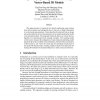Free Online Productivity Tools
i2Speak
i2Symbol
i2OCR
iTex2Img
iWeb2Print
iWeb2Shot
i2Type
iPdf2Split
iPdf2Merge
i2Bopomofo
i2Arabic
i2Style
i2Image
i2PDF
iLatex2Rtf
Sci2ools
BMVC
2000
2000
Quantifying Ambiguities in Inferring Vector-Based 3D Models
This paper presents a framework for directly addressing issues arising from self-occlusions and ambiguities due to the lack of depth information in vector-based representations. Visual data directly observed from an image are used to indirectly recover the parameters of an underlying dynamic model of an articulated object. The proposed framework allows us to learn the ambiguities of a representation from training examples. The resulting model is then used to measure the ambiguities of each estimated underlying model parameter given the available visual information. This provides an indication of how much we can "trust" the visual data for estimating certain parts of the model. We then provide a working example of multi-view data fusion for tracking 3D skeletons of articulated objects in a multi-camera environment.
| Added | 01 Nov 2010 |
| Updated | 01 Nov 2010 |
| Type | Conference |
| Year | 2000 |
| Where | BMVC |
| Authors | Eng-Jon Ong, Shaogang Gong |
Comments (0)

